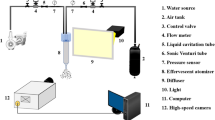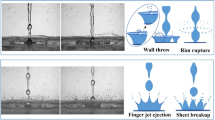Abstract
Based on the observation of the working condition in pressure swirl atomisation experiments, this article tries to suggest a model of the mechanism of pressure swirl atomisation—the atomisation theory of pressure swirl spray of conical film. Under some basic assumptions, the formula for the characteristic of droplet size of pressure swirl atomisation is derived:
The above theory agrees basically with the actual working conditions in atomisation, and gives the latter a compratively good interpretation.
In this article, theoretical calculations are worked out for the characteristic of atomised droplet size of some Oil atomising nozzles used in power plants in our country (the People's Republic of China) and are compared with actual test data. The results show that the theory is of some value to preactice, and it is recommended to those concerned for reference.
Similar content being viewed by others
References
Xian Thermal Engineering Institute, The cold-state test of the mechanical atomizing oil nozzle for power plant boilers,Thermodunamic Electric Power Generation, 7 (1976). (in Chinese)
Hubei Electric Power Desigring Institute,A Group of Compilers of Oil Burning Design for Electric Power Plants, Oil burning design for electric power plants, Dec. (1975). (in Chinese)
Lu Ding-yuan, Study on the characteristic of the spray angle in pressure swirl atomisation, Shanghai Textile Industry Design Institute (1979). (in Chinese)
Iwashita Soo Kichi, Burn characteristics and factor of effect for heavy oil burnen,The Thermal Power,18, 3 (1967), 29. (in Japanese)
Chemical Engineering Institute, The atomisation of liquid,Modern Chemical Engineering (1971). (in Japanese)
Giffen, E. and A. Maraszen,The Atomisation of Liquid Fuels (1953).
Weber, G., Burner of press are atomisation for oil fired boiler of middle and great size,VGB H106 (1967, 1. (in German)
Brahof, A.M., New direction of the theory for centrifugal nozzle,Thermoenergy Energetics, 2 (1963), 26. (in Russian)
Gille, G.E. and M.A. Mollowsinkin, Calculation method and structure for heavy oil centrifugal nozzle,Thermoenergy Energetics,4 (1963), 87. (in Russian)
Mollowsinkin, M.A., Calculation of coefficient of flow for centrifugal nozzle,Thermoenergy Energetics, 12 (1967), 81. (in Russian)
Mucofe, M. B.,Atomizing Desiccation (1966). (in Russian)
Rocifes, A.C.,Atomisation of Fual of Diesel Engine on Board Ship 1971). (in Russian)
Bach, D. G.,Atomizing Machinery (1975). (in Russian)
Author information
Authors and Affiliations
Additional information
Communicated by Chien Wei-zang
Rights and permissions
About this article
Cite this article
Ding-yuan, L. Theory of pressure swirl atomisation and study on the characteristic of droplet size in atomisation. Appl Math Mech 7, 1101–1114 (1986). https://doi.org/10.1007/BF01897212
Received:
Issue Date:
DOI: https://doi.org/10.1007/BF01897212




